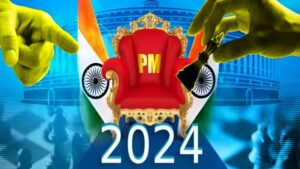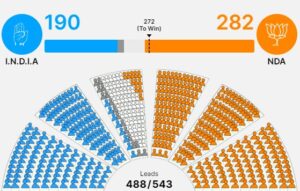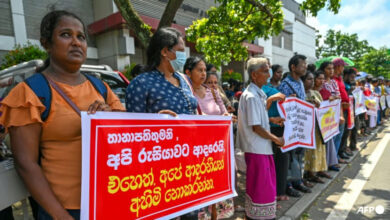India Election Update 2024: Modi’s BJP Likely to Fall Short of Majority

As per the latest reports from the Election Commission, while the BJP has performed strongly in several regions, it appears that they might not secure the requisite number of seats to form a government independently. This outcome marks a significant shift from the landslide victories the BJP has experienced in previous elections.
Political analysts attribute this development to a combination of factors, including growing dissatisfaction with certain policies of the Modi government, regional dynamics, and the emergence of strong opposition alliances in key states.
With the BJP’s potential failure to secure a majority, attention now turns to the possibility of coalition-building and post-election negotiations among political parties. The formation of a coalition government or a minority government supported by allies could shape the country’s political landscape in the coming years.
As the final results continue to trickle in and the political scenario evolves, all eyes remain firmly fixed on the unfolding developments, which are poised to redefine India’s political trajectory in the years ahead. Stay tuned for further updates as the situation unfolds.

Tensions with China weigh heavily as Modi seeks a third term following an electoral campaign centred on making India a major global power.
China and India are vying for the role of leaders of the Global South. Modi has projected India as a key member of the BRICS club of emerging economies, and this week called New Delhi “a strong and important voice of the Global South”.
It was under Modi’s watch that the African Union bloc joined the G20, with India arguing developing nations need a greater say in global decision-making.
Tensions between the world’s two most populous countries were heightened in 2020, when their troops fought a deadly high-altitude skirmish along their 3,500-km (2,200-mile) frontier.
Tens of thousands of troops from the nuclear-armed Asian giants continue to eyeball each other. Modi’s right-wing government has pumped billions of dollars into border infrastructure and boosted military spending by 13 percent last year.
Maharashtra: Opposition trumping BJP alliance
Maharashtra, India’s second-most politically critical state, appears positioned to throw up a surprising election result. Exit polls had projected that the BJP and its allies would win 33 or more seats out of 48 in the state.
But as more and more rounds of votes are counted, the opposition INDIA alliance looks firmly ahead, leading in 28 seats, while the BJP and its allies are ahead in 19, with an independent candidate leading in the other seat. On its own, the BJP is leading in just 11 seats.
Maharashtra is home to India’s financial capital Mumbai, and is the state with the largest GDP in India.
What does a third term for Modi mean for the US and Europe?
The United States wants India to be a strategic counterweight to China. President Joe Biden hosted Modi for a state dinner last year and has called ties with New Delhi the “defining partnership of the 21st century”.
Biden and Modi hailed a new era in their countries’ relationship last year after the White House rolled out the red carpet for the Indian prime minister, touting deals on defence and commerce aimed at countering China’s global influence.
“The stability of the region has become one of the central concerns of our partnership,” Modi had said after a state dinner in Washington, DC.
In February, the US approved a $4bn sale of state-of-the-art drones to India.
India also has strong ties with European countries. With France, it hopes to expand multibillion-dollar deals, including the sale of Rafale fighter jets and Scorpene-class submarines.
That deepening of ties has come despite rights groups sounding the alarm about threats to India’s democracy and increased discrimination towards the 200 million-plus Muslim minority.
BJP’s Irani trailing by more than 50,000 votes in Amethi
The Congress’s Kishori Lal Sharma is leading in the Gandhi family’s bastion of Amethi in key Uttar Pradesh state by more than 50,000 votes against BJP heavyweight Smriti Irani, according to the latest election commission figures.
In 2019, Congress leader Rahul Gandhi lost Amethi by 55,000 votes to Irani, a minister in Modi’s government. This year, Gandhi is contesting from neighbouring Rae Bareli constituency.
What we know so far
It’s 12:50pm in India, and after almost five hours of counting, the trends have started to solidify, even though dozens of constituencies will still be decided by narrow margins.
It’s 12:50pm in India, and after almost five hours of counting, the trends have started to solidify, even though dozens of constituencies will still be decided by narrow margins.
Here are the key takeaways at the moment:
Prime Minister Modi’s BJP is poised to emerge as the single-largest party, but could fall short of a majority on its own. It currently leads in 241 seats in a house where the majority mark is 272 seats.
The BJP’s alliance, the NDA, is projected to cross the 272 mark — a scenario in which a weakened BJP would lead the next government, reliant on its allies. The BJP alone won 303 seats in 2019 and 282 seats in 2014.
The opposition INDIA alliance appears poised for big gains in Uttar Pradesh, Maharashtra and West Bengal — India’s three biggest states — while holding on to key bastions like Tamil Nadu.
The BJP could make a breakthrough in the southern state of Kerala, where it is leading in two seats. The party has never won a Lok Sabha seat in Kerala before.
‘Authoritarianism a threat if BJP wins reduced majority’
While exit polls had predicted another Modi landslide, the opposition has so far been performing better than expected, political analyst Gilles Verniers tells Al Jazeera.
“Should early trends hold, this will be a setback for the prime minister and for the BJP, which had set its target high at 400 seats,” said Verniers.
He added that while the numbers may change as votes are counted, “the verdict so far [is] that the BJP’s claim of invincibility in national elections is dented, including in its Hindi belt stronghold”. The belt refers to Hindi-speaking states in the north.
How Modi would act in a third term with a reduced majority remains to be seen, said Verniers.
“While an internal leadership challenge remains out of the question, there may be a temptation to push towards further authoritarianism to compensate for the loss of political ground and keep alliance partners in check,” he said.
BJP alliance leads in more than 280 seats
The BJP-led NDA alliance is leading in 283 seats while the Congress and its partners do better than anticipated and are ahead in 219.
The BJP on its own is leading in 239 seats – 33 short of a majority – while a resurgent Congress alone is ahead in 94 constituencies.


![Mumtaz Zahra Baloch, spokesperson for Pakistan's Foreign Ministry, says the country believes in constructive dialogue with the US [Courtesy of Pakistan Ministry of Foreign Affairs]](https://southasiancorrespondent.com/wp-content/uploads/2024/06/pak-1-390x220.jpg)

